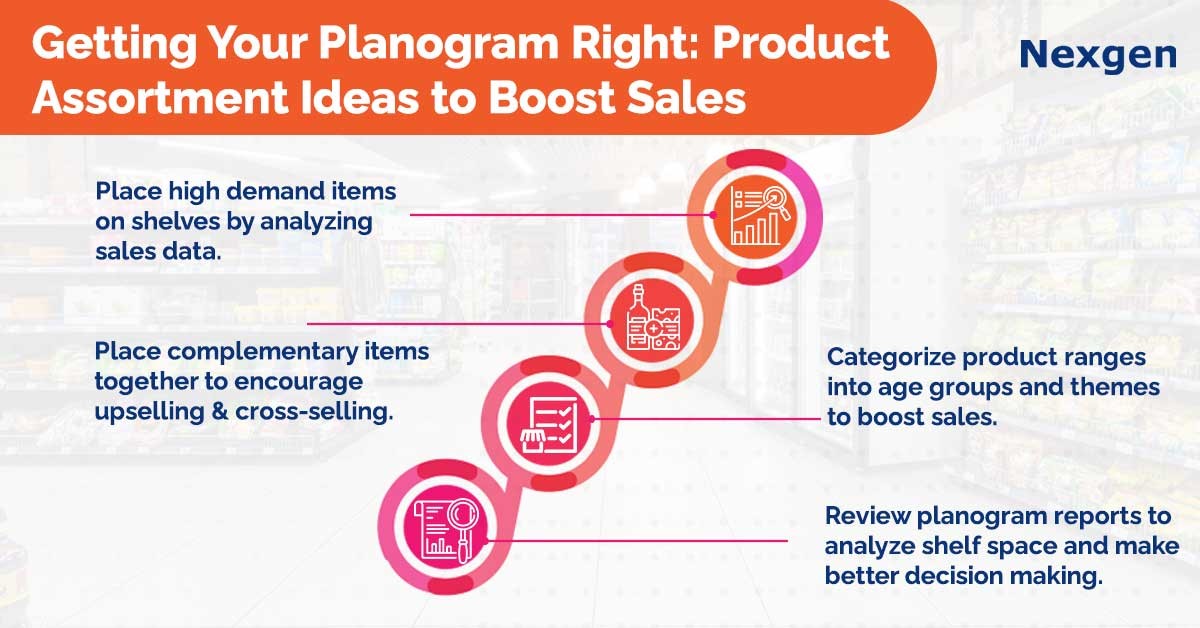In retail stores, every square foot and every product is important. One single mistake in your product assortment and planning process can result in losing sales, tarnishing your brand image and shopper trust. So, how can you ensure your retail assortment strategies guarantee the success of your store with planograms? Planograms are visual merchandising tools, that help retailers design product shelves by putting their customer’s needs first, keeping their assortment focused and organized, and staying adaptable to changing market conditions to drive sales.
A well-organized and thought-out planogram in retail can significantly impact your retail store's success. It is not just about placing products on shelves; it is about creating an appealing shopping experience that maximizes sales and customer satisfaction. One of the critical aspects of a planogram is product assortment – the selection of items you choose to feature in your store. In this blog post, we will explore the top three product assortment mistakes to avoid, ensuring your planogram is optimized for success.

1. Neglecting customer preferences and market trends.
One of the most common mistakes retailers make when creating a planogram is ignoring customer preferences and current market trends. Your customer’s needs and desires should be at the forefront of your assortment decisions. Failing to align your product offerings with what your target audience wants can result in poor sales and customer dissatisfaction.
Imagine you own a small boutique that specializes in women's fashion. You have been in business for a few years, and your inventory primarily consists of classic styles and timeless pieces. However, in recent months, you have noticed a shift in customer preferences. More and more shoppers are looking for sustainable and eco-friendly fashion options. In this scenario, neglecting customer preferences and market trends would mean continuing to stock only traditional clothing items without adapting to the changing landscape of the fashion industry. To avoid this mistake, conduct market research, analyze sales reports, and customer surveys to pay attention to the products that are in high demand and emerging trends in your industry. Use this data to improve your product assortment decisions, ensuring you stock items that resonate with your customers.
2. Overcomplicating the assortment.
Having a diverse product assortment can be beneficial, but it is essential to strike the right balance. Overcomplicating your assortment by offering too many similar products or unrelated items can overwhelm customers and make their shopping experience confusing. It can also lead to overstocking issues, increased operational costs, and difficulties in maintaining inventory accuracy.
For example, if you have a local electronics store specializing in consumer gadgets and accessories, your initial strategy was to offer a broad range of products, believing that more choices would attract a wider customer base. However, this approach has led to some unintended consequences, such as the fact that shelves have become crowded with numerous similar products, making it challenging for customers to differentiate between them. For instance, you stock a wide array of smartphone cases, from budget-friendly options to premium, designer cases, in various colors and styles. To avoid this mistake, categorize your products effectively. Group similar items together and create clear sections or aisles for different product categories. Prioritize the products that are most popular and profitable for your store, and consider reducing or eliminating those that do not perform well. A focused and well-organized assortment simplifies the shopping process for your customers and helps improve sales.
3. Failing to regularly review and update assortments.
The retail landscape is dynamic, and customer preferences can change rapidly. Failing to regularly review and update your product assortments is a significant mistake. Outdated or stagnant assortments can lead to missed sales opportunities and a decline in customer interest.
Imagine you run a small boutique clothing store in an urban neighborhood. When you first opened your store five years ago, you carefully curated a selection of trendy clothing items that catered to the young, fashion-forward demographic in your area. Your store quickly gained a loyal customer base, and your sales were booming. Over time, you noticed a decline in foot traffic and sales. Customers who were once regulars started to explore other stores in search of fresher fashion options. You phased out the outdated items and introduced fresh, trendy pieces that aligned with the current fashion landscape by reviewing and updating your planograms and product assortments. This helped improve the overall store experience and resulted in boosting sales.
Overview of Nexgen POG
Nexgen POG is a robust and user-friendly cloud-based visual merchandising tool. It is designed for quick and efficient planogramming with minimal effort. Planogram in retail can be designed by easily dragging and dropping the products. The multi-device compatibility feature of POG allows you to obtain, share and edit planogram on any device, including your phone. It helps in designing store-specific planograms for increased product visibility and sales.
Get Your Free Trial Now!